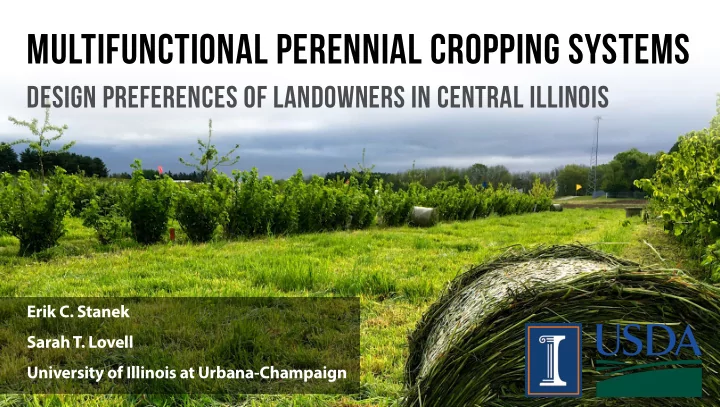

Multifunctional Perennial Cropping Systems design preferences of landowners in Central Illinois Erik C. Stanek Sarah T. Lovell University of Illinois at Urbana-Champaign
Todays discussion 1. Agroforestry potential in Central Illinois 2. The design of agroforestry systems for landowners 3. Landowner preferences, motivators, and barriers 4. Improving conservation and agroforestry use Cover & below photo courtesy of Kevin Wolz
We know agroforestry... ...But what are multifunctional perennial cropping systems (MPCs)?
How can we make this a reality for landowners?
Understanding Central IL landowners • Previous work surveyed ~100 Central Illinois landowners about MPCs • Highest potential adopters were young, valued conservation, willing to learn. • Biggest barrier was lack of information W
Improve information for landowners Source: Mattia et al. 2016, Identifying barriers and motivators for adoption of multifunctional perennial cropping systems by landowners in the Upper Sangamon River Watershed
Research questions and methods • How can we improve design and in turn advance research? • What is the preferred agroforestry design? • What are the motivators and barriers to adopting agroforestry? • What more information do landowners need?
Design for landowners, with landowners • 15 landowners within Land Use 77% agriculture (corn/soy) the Upper Sangamon 12% developed River Watershed 5% grassland/forest • Landowner ages between 29 to 78 • Eight are full-time farmers of some type Mattia et al. 2016
Creating MPCs from landowners goals Initial Meeting • Visit the land and identify areas to be used • Understand wants and needs Building Scenarios • Outline goals for MPCs • Used normative scenario design • Plausible and reasonable situations that could and/or should exist in the future. • Collaborative process to achieve a novel Source: Nassauer, J.I., Corry, R.C. 2004, Using agricultural system normative scenarios in landscape ecology
Three scenarios guided design Production Conservation Cultural • High production of • Use of native species • Visually beautiful woody crops • High diversity • Recreation and • Mechanically experience • Eligible for harvestable • Research and conservation • Simplicity programs education
How are the designs created?
Design workfmow aims to meet landowner needs
What do the designs look like?
Production
Conservation
Cultural
What do the landowners think?
Narrowing in on preferences Design materials provided • Designs x3 • MPCs Information Book Interview #2 • Preferences, motivators/barriers, adoption potential, building an optimal design
Results indicate production is most important Preferred design by landowners (rank frequency) Rank Production Conservation Cultural 1 8 4 3 2 3 10 2 3 4 1 10 Interest 3.6 3.2 3.4 score Likert Scale Rating 1 2 3 4 5 Not at all interested Slightly interested, Somewhat Moderately interested, Extremely interested, would not adopt would adopt very Interested, would would adopt a good Would adopt most or little of the design adopt some of the amount of the design all of the design design
Results show value in working face to face Likert-scale rating 1 2 3 4 5 Not at all Slightly Somewhat Moderately Extremely Higher MPCs familiarity Usefulness of the design process • Before and after: 2.53 3.53 • Supplemental guide was most useful (average of 4.73) 13 out of 15 participants said they Higher MPCs adoption likelihood plan to adopt MPCs • Before and after: 3.53 4.13
How much of a barrier/motivator are the following? 0 1 2 3 4 5 6 Persuades Not at all Slight Somewhat Moderate Very Extreme me to adopt or not Top Motivators Top Barriers 1. Growing high-value, edible crops 1. Lack of infrastructure for post-harvest (4.73) processing and packaging (4.13) 2. Improving pollinator & wildlife 2. Time and labor requirements (3.8) habitat (4.46) 3. Three tied (3.6) 3. Productive use of marginal land (4.4) »Lack of markets »Lack of harvesting equipment Ten participants stated this become more »Unfamiliarity with products/enterprises important after the study
Continuing to move forward Future Work Research needed • Field days and work with extension • Building lots of Markets » “I would, if there was a market” • Long-term Field Trials with Select Participants • Harvest machinery adapted to common systems (species mixing) • Planning and Management Guide • Improving funding opportunities for systems
Why should the general public care about agroforestry design?
Marginal lands ofger signifjcant returns • 7% of land was classified as marginal and suitable for MPCs • 56% reduction in soil erosion by converting to MPCs (Mattia et al. 2017, In review ) Marginal soils identified ( Source: Mattia et al. 2017, In review)
Rethinking how we do “conservation” #1 practice in Illinois is CP1- Total CRP for Illinois as of May 2017 Establishment of Permanent # of #of Total Total Avg. contracts farms acres rental $ rental/acre Introduced Grasses and Legumes (176,656 acres) 78,748 43,678 895,862 $161,815,000 $181 CRP monthly summary – May 2017, USDA For this study: Cost to design agroforestry on all Illinois CRP farms = $21,839,000 • Average time spent per farmer roughly 10 hrs. This is a one time investment, » Each farmer costs $500 CRP is each year
Acknowledgments Funding and support Expertise and outreach • United States Department of • Jay Hayek, Doug Gucker, and all of the Agriculture UIUC Extension • The University of Illinois at Urbana- • The Institute for Sustainable Energy Champaign (UIUC) and Environment at UIUC • Savanna Institute Research and design • All of the MPCs study participants • Dawei Huang • Matt Wilson • Chloe Mattia
Recommend
More recommend